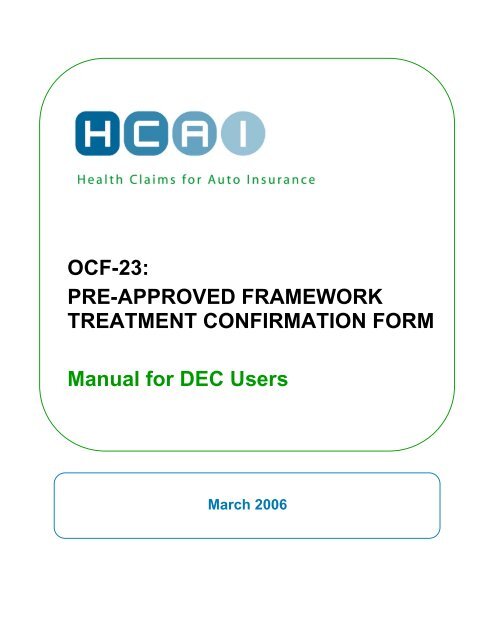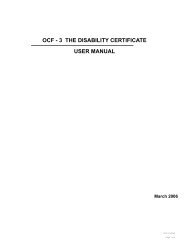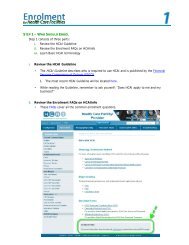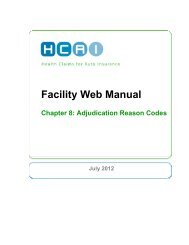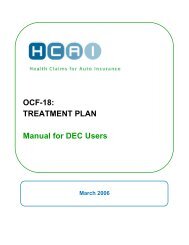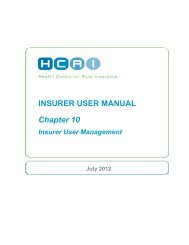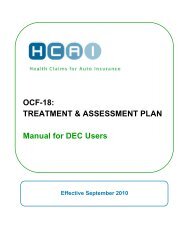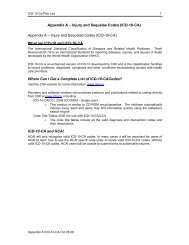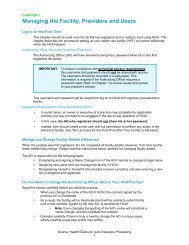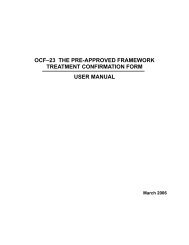Injury and Sequelae Codes (ICD-10-CA) - HCAI
Injury and Sequelae Codes (ICD-10-CA) - HCAI
Injury and Sequelae Codes (ICD-10-CA) - HCAI
Create successful ePaper yourself
Turn your PDF publications into a flip-book with our unique Google optimized e-Paper software.
OCF-23:PRE-APPROVED FRAMEWORKTREATMENT CONFIRMATION FORMManual for DEC UsersMarch 2006
Document Change HistoryDate Description of Change Reason20050214 Revised Applicant Signature, Signature ofthe Initiating Health Practitioner & Prior &Concurrent Conditions, RepositionedSignature of Insurer20060301 Further Information <strong>and</strong> Revised ApplicantSignatureChanges are underlined.For consistency with revised OCF forms01/Dec/04Redirects Users to H<strong>CA</strong>I website <strong>and</strong>revised consent for consistency.IntroductionWho should use this manual?This User Manual is designed to assist both health care providers <strong>and</strong> automobile insurers in thecompletion of the OCF–23, The Pre-Approved Framework Treatment Confirmation Form. Other manualsare available to assist in the completion of:OCF–3Disability CertificateOCF–18 Treatment PlanOCF–21 Auto Insurance St<strong>and</strong>ard InvoiceOCF–22 Application for Approval of an Assessment or ExaminationOCF–24 Pre-Approved Framework Discharge & Status ReportFacilities <strong>and</strong> health care providers dealing with victims of motor vehicle accidents are required to usethese forms.Both rehabilitation health care providers <strong>and</strong> automobile insurers have dedicated a tremendous amount oftime <strong>and</strong> thought to the revision or development of the Pre-approved Framework Treatment ConformationForm <strong>and</strong> other forms. These forms will improve the accountability of all parties, streamline the processof delivering health care services to applicants, <strong>and</strong> enhance communication between insurers <strong>and</strong> healthcare professionals.The forms are designed to facilitate a clear underst<strong>and</strong>ing of the interactions amongst an injured motorist,a health care professional <strong>and</strong> an insurer through the use of common terms <strong>and</strong> language. All forms usethe national coding st<strong>and</strong>ards, the International Statistical Classification of Diseases <strong>and</strong> Related HealthProblems, Tenth Revision, Canada (<strong>ICD</strong>-<strong>10</strong>-<strong>CA</strong>) 1 , to identify injuries <strong>and</strong> the Canadian Classification ofHealth Interventions (CCI) 1 to classify health care services <strong>and</strong> procedures.1 <strong>ICD</strong>-<strong>10</strong>-<strong>CA</strong> <strong>and</strong> CCI are copyright products of the Canadian Institute for Health Information (CIHI) <strong>and</strong> may not be changedwithout the Institute’s express permission.1
What is in this manual?The manual provides detailed instructions for completion of the fields in the order in which they appear onthe forms. The appendices include tables of st<strong>and</strong>ardized codes <strong>and</strong> descriptions for the various codifiedfields used on the forms.Where can I get more information?The manual will be updated from time to time. The latest updates to the manual can be downloaded fromthe website www.hcaiinfo.ca under Auto Insurance Resources>Statutory Accident Benefits>UserManuals.Contact your professional association for any questions relating to coding of injuries, interventions, healthcare services <strong>and</strong> guidelines as they relate to your specific practice.Samples of Completed Sections of the FormsThe samples <strong>and</strong> fees used throughout the manual are entirely fictitious. They are designed toassist you in underst<strong>and</strong>ing how to use <strong>and</strong> complete the forms.2
OCF-23Pre-approved Framework Treatment Confirmation FormBackgroundThe health practitioner who initiates pre-approved treatment for an injury defined in a Pre-approvedFramework (PAF) must fully complete a Pre-approved Framework Treatment Confirmation Form, OCF-23, in order to establish the Initiating Health Practitioner’s right to reimbursement for the delivery of PAFtreatment. The OCF-23 is also the form used to request insurer approval of those treatments that arepermitted to be delivered together with treatment in the PAF, but which also require insurer approval.Purpose:To describe the injuries which are a direct result of the motor vehicle accident.To identify to the insurer the relevant PAF program of care <strong>and</strong> any related pre-approved goods<strong>and</strong> services that will be provided.To request insurer approval of any treatments permitted in the PAF that require pre-approval.To provide speedy confirmation to the provider that there is an insurance policy in existence toenable reimbursement.To identify any prior conditions <strong>and</strong>/or barriers to recovery that could affect the claimant’sresponse to the treatment.This form may not be materially altered; in other words, the document cannot be changed in any manner.If this document is materially altered, it may be considered incomplete <strong>and</strong> the insurer may not accept theform.When is an OCF-23 required?The initiating practitioner must submit the OCF-23 as soon as possible <strong>and</strong> no later than five daysfollowing the practitioner’s first encounter with the claimant. After receipt of the OCF-23, the insurer hasfive days to inform the provider that there is an insurance policy in place to respond to invoices.There will normally be only one OCF-23 per patient. However, exceptions to this can occur, includingwhen:• an ancillary service* is proposed by the initiating practitioner, family physician or insurer, eitherwhen the PAF is initiated or after treatment is underway. The proposal <strong>and</strong> approval of theancillary service are documented through an OCF-23 that is signed by the initiating healthpractitioner or the patient’s physician. Thus, if the insurer wishes to initiate an ancillary service,the insurer shall do so by contacting either the initiating practitioner or the patient's familyphysician, who will complete the OCF-23.• the initiating practitioner determines, after treatment is underway, that the patient needs a good(e.g. equipment) to support treatment or that a supplementary condition exists which requires theSupplementary Condition service.• the patient decides to change practitioners while there are resources remaining in the PAF, inwhich case the patient <strong>and</strong> second practitioner must inform the insurer through submission of anew OCF-23.• the initiating provider of a WAD I PAF determines that the patient is more appropriately treated inthe WAD II PAF. In this case, the total cost of PAF treatment must not exceed the cost of theWAD II PAF <strong>and</strong> must be documented in a new OCF-23.* Refer to the PAF Guidelines for more information. An Activities of Normal Life Intervention (ANLI) isused to identify <strong>and</strong> evaluate areas of functional difficulty or barriers to recovery <strong>and</strong> to implementstrategies for recovery.3
Who completes this form?The health practitioner who undertakes the responsibility for treating the patient in the PAF completes <strong>and</strong> submits theOCF-23. By signing Part 5, the health practitioner is affirming that the goods <strong>and</strong> services contemplated are reasonable<strong>and</strong> necessary for the injuries described in Part 6.The applicant or a substitute decision maker completes Part 1 <strong>and</strong> 2 <strong>and</strong> signs Part 13. The Substitute Decisions Actstates that a substitute decision maker is a person with power of attorney for personal care or a court appointed guardian.The insurer completes Part 12 <strong>and</strong> returns a copy of the page to the applicant <strong>and</strong> the health practitioner.FeeThe fee for completion of this form is embedded in the block funding structure of the PAF. Therefore, the insurer may notbe billed separately for completion of this form.Return this form to:Enter the name <strong>and</strong> mailing address of the Insurance Company responsible for h<strong>and</strong>ling the claim.Claim IdentifiersThe Applicant must indicate the claim number if known, the policy number, <strong>and</strong> the date of the accident. The claimnumber <strong>and</strong> policy number can be obtained from the insurance adjuster. The policy number is also available on the MotorVehicle Liability Insurance Card (pink slip) received with the policy declaration.The Claim Number <strong>and</strong> Policy Number may be the same.The accident date must be completed. Forms will not be processed without it. If a patient has overlapping injuriesfrom more than one accident, use the date of the accident that is most relevant to the injuries being treated.
Part 1Applicant InformationTo be completed by the Applicant.Part 2Insurance Company InformationTo be completed by the Applicant.Part 3Other Insurance InformationOther insurance may be available from the Ministry of Health <strong>and</strong> Long-Term Care (MOH) or through an applicant’spersonal, spousal, or parental Extended Health Care plan to cover or partially cover some or all of the goods <strong>and</strong> serviceslisted.Indicate if the treatment you will be providing is covered by the MOH.Determine other insurance coverage that the applicant might have. Space is available for two other insurers in the eventthat the applicant is covered by more than one policy (for example, if both the applicant <strong>and</strong> the applicant’s partner orlegal guardian have extended health benefits).The auto insurer is not liable for any costs which are payable by any other insurer.5
Part 4Conflict of Interest DefinitionBefore proceeding to the rest of the form, determine if you have a conflict of interest relating to this Pre-approvedFramework Treatment Confirmation Form.Part 5Signature of Initiating Health PractitionerOnly Health Practitioners can initiate a PAF. According to the Statutory Accident Benefits Schedule (SABS), healthpractitioners are chiropractors, dentists, nurse practitioners, occupational therapists, optometrists, physicians,physiotherapists, psychologists <strong>and</strong> speech-language pathologists. Only the Initiating Health Practitioner or the familyphysician may sign Part 5. The signature is required before the form can be submitted to the insurer.If you are not the first initiating health practitioner, you must check the box provided.If the insurer wishes to initiate an ancillary service, the insurer shall do so by contacting either the initiating practitioner orthe patient's family physician, who will complete the OCF-23.Before signing Part 5, confirm that the requirements for informed consent have been met. The inclusion of a revisedstatement of underst<strong>and</strong>ing identifies for the Initiating Health Practitioner the range of specific uses that will be made ofinformation related to providing services to injured auto insurance claimants.6
Part 6<strong>Injury</strong> <strong>and</strong> <strong>Sequelae</strong> InformationProvide a brief description of the injury <strong>and</strong> the corresponding injury code (<strong>ICD</strong>-<strong>10</strong>-<strong>CA</strong> code). List the PAF injury first. Upto four injuries/sequelae may be entered including the description <strong>and</strong> a valid <strong>ICD</strong>-<strong>10</strong>-<strong>CA</strong> code.Refer to Appendix A for further information on <strong>ICD</strong>-<strong>10</strong>-<strong>CA</strong>.Refer any questions regarding injury coding to your provider association or access the website at www.hcaiinfo.ca underAuto Insurance Resources>Statutory Accident Benefits><strong>Codes</strong> <strong>and</strong> Appendices.Part 7Prior <strong>and</strong> Concurrent ConditionsThe information provided in this section will help the insurer to better underst<strong>and</strong> the applicant’s pre-accident status <strong>and</strong>informs the insurer in advance of any pre-existing condition that may affect the applicant’s response to the treatment givenwithin the PAF. Provide relevant information in response to these questions to the best of your knowledge <strong>and</strong> based oninformation from the applicant. A response of “Unknown” may prompt a request for further clarification from the insurer.Inclusion of the question on employment status exp<strong>and</strong>s on the insurer’s underst<strong>and</strong>ing of the applicant’s pre-accidentstatus.7
Part 8Barriers to RecoveryIdentify any barriers to recovery, including any “yellow flags” identified in the PAF outline that may affect the success ofthis treatment.Refer to Appendix G for further information on “yellow flags” specific to the PAF.Part 9PAF Pre-approved ServicesIdentify the PAF guideline under which you are treating (e.g., WAD II PAF) <strong>and</strong> indicate the maximum fee allowed underthis PAF as well as your estimated fee for provision of the services. These two numbers may be different if you anticipatethat not all blocks of the PAF will be required in order to treat <strong>and</strong> discharge this patient.Identify any pre-approved Supplemental Goods, Condition Services or other pre-approved services allowed under thePAF guideline that the patient will require, <strong>and</strong> insert the associated maximum <strong>and</strong> estimated costs.Part <strong>10</strong>Other Health ProvidersThis part should be filled in only if there are goods <strong>and</strong> services requiring prior approval (Part 11).Health Providers are assigned an upper case alphabetic letter (i.e., the Provider Reference). The Provider Referenceletters are used to cross-reference information on the Pre-approved Framework Treatment Confirmation Form <strong>and</strong> theAutomobile Insurance St<strong>and</strong>ard Invoice.Assign a Provider Type code for each of the health professionals rendering services or prescribing goods.8
Refer to Appendix E for a complete list of Provider Type codes.If you are a regulated health professional, provide your college registration number <strong>and</strong> leave the AISI number blank. Ifyou are an unregulated provider, you can obtain an AISI number by registering at www.hcaiinfo.ca.NB Future implementation of the H<strong>CA</strong>I system may eliminate the need for an AISI number.Because hourly rates are generally not applicable to Pre-approved Frameworks, enter N/A (not applicable). The exceptionto this is the Activities of Normal Living Intervention (ANLI), for which the hourly rate of the provider must be entered.Part 11Other Goods or Services within the PAF Guidelines Requiring Insurer ApprovalThis section is for services allowable under the PAF Guideline, but still requiring insurer approval.DescriptionEnter a description of the good or service provided.Code <strong>and</strong> AttributesFor those services representing a diagnostic, therapeutic, or health care support intervention, enter a valid CCI code <strong>and</strong>attribute if required.Refer to Appendix B for a list of CCI codes <strong>and</strong> corresponding Attribute <strong>Codes</strong>.For Goods, Administration <strong>and</strong> other codes (GAP) not included in the CCI code set, enter a valid GAP code.Refer to Appendix C for a list of valid GAP codesRefer any questions regarding goods <strong>and</strong> service coding to your provider association or access the website atwww.hcaiinfo.ca.Provider ReferenceEnter the Provider Reference code of the professional who will render the service or is prescribing the good (from Part<strong>10</strong>).When a service is to be provided by more than one health care professional, enter all Provider Reference codes(separated by commas).9
EstimatedIn the three columns under this heading, you are to enter the elements of information that are needed to calculate theestimated total cost of each good <strong>and</strong> service that will be delivered. First, enter the total quantity of the good or service that will be delivered; this will appear as a number (e.g., 75, 6,52…).Sub-TotalSecond, identify the unit of measure (e.g., hours of service, number of pages, kilometres of travel) for the quantityof service you are proposing to deliver each treatment day.Third, report the cost per service.Enter the total cost of goods or services proposed in Part 11.TotalEnter the combined total of the estimated fees from Part 9 <strong>and</strong> Part 11.Part 12Signature of InsurerThe insurer will complete this section <strong>and</strong> return page 3 to the applicant <strong>and</strong> the Initiating Health Practitioner indicated inPart 5. If there is a service requiring insurer approval on the plan, <strong>and</strong> the insurer partially approves or does not approvethe treatment, it must provide an explanation as to why the additional service has been declined. In this case, the providermay submit a Treatment Plan (OCF-18) for the declined services, <strong>and</strong> approval will be subject to the SABS<strong>10</strong>
Part 13Signature of Applicant(Partial Print Screen)After you have reviewed the form with the applicant, the applicant or the applicant’s Substitute Decision Maker, as definedin the Substitute Decisions Act, must sign here. The insurer may elect to waive the requirement of the applicant signature,but this should be ascertained in advance.The consent for the use of information has been revised to reflect the current privacy legislation <strong>and</strong> other legislation withwhich insurers must comply. Insurers are responsible for ensuring that claimants underst<strong>and</strong> these conditions wheninitiating a claim through the submission of an OCF-1.Should the claimant require more information about the consent <strong>and</strong> their obligations, please refer him/her to theirinsurance claims adjuster.11


